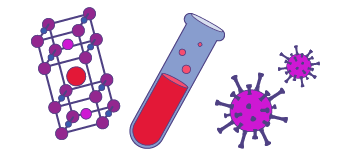PELDOR, also known as DEER (Double Electron Electorn Resonance), has been demonstrated as a powerful tool for studying the topology and associated structural changes in proteins and nuclear acids.
The recent resurgence of EPR in structural biology is in large part due to the development of pulsed EPR techniques and their applications in biological systems, especially distance measurements - PELDOR. PELDOR, also known as DEER (Double Electron Electron Resonance), has been demonstrated as a powerful tool for studying the topology and associated structural changes in proteins and nuclear acids. PELDOR is sensitive to spin-spin distance from 15 to ~100 Å, which is suitable to study large protein complexes. The EMR facility at the MagLab is equipped with two pulsed spectrometers that are capable to perform PELDOR experiments at 9.5 and 95 GHz.

Explore our magnet schedule to see what exciting research is happening on our stellar fleet of instruments right now.
Sun ZY, et al, Disruption of Helix-Capping Residues 671 and 674 Reveals a Role in HIV-1 Entry for a Specialized Hinge Segment of the Membrane Proximal External Region of gp41. J Mol Biol. (2013) Read online.
Vileno, B, et al, Broad disorder and the allosteric mechanism of myosin II regulation by phosphorylation. P. Natl. Acad. Sci. U.S.A.,108 (2011) Read online.>
Song L, et al, Distance and dynamics determination by W-band DEER and W-band ST-EPR. Eur Biophys J. (2010) Read online.
Fajer PG, et al, Practical Pulsed Dipolar ESR (DEER), Chapter 4 - ESR Spectroscopy in Membrane Biophysics, 27:95-128, ISBN: 978-0-387-25066-3 (2007) Read online.
Last modified on 22 August 2023